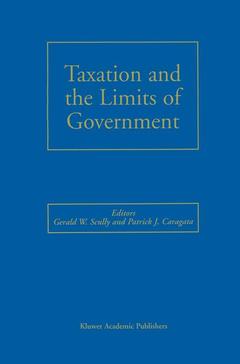Description
Taxation and the Limits of Government, 2000
Coordinators: Scully Gerald W., Caragata Patrick J.
Language: English
Subject for Taxation and the Limits of Government:
Taxation and the Limits of Government
Publication date: 10-2012
310 p. · 15.5x23.5 cm · Paperback
Publication date: 10-2012
310 p. · 15.5x23.5 cm · Paperback
Taxation and the Limits of Government
Publication date: 04-2000
310 p. · 15.5x23.5 cm · Hardback
Publication date: 04-2000
310 p. · 15.5x23.5 cm · Hardback
Description
/li>Contents
/li>Biography
/li>
Recently, a research program on the compliance costs and the economic effects of taxation in New Zealand was undertaken within the Inland Revenue Department. Taxation and the Limits of Government is an edited volume which presents the best of the papers that emerged from that research program. Topical coverage includes a brief history of reform in New Zealand, the effect of taxation on economic growth, the marginal cost of taxation, the employment effects of taxation, income distribution, the hidden economy and taxation, tax compliance, taxation and bankruptcy, and estimates of effective tax rates.
List of Authors. Part 1: Background. 1. An Introduction to Reform and the Economic Effects of Taxation in New Zealand; G.W. Scully, P.J. Caragata. Part 2: Taxation and Economic Growth. 2. The Optimal Size Fiscal State; G.W. Scully. 3. Taxation and Economic Growth in New Zealand; J. Branson, C.A. Knox Lovell. 4. The Effect of Aggregate Tax Levels on Output Growth in New Zealand; J. Small, P.J. Caragata. Part 3: The Marginal Cost of Taxation. 5. The Deadweight Costs of Taxation in New Zealand; W.E. Diewert, D.A. Lawrence. 6. The Distribution of Estimates of the Marginal Cost of Taxation; J. Small. Part 4: Taxation and Employment. 7. Taxation and Employment in New Zealand; G.W. Scully. Part 5: Income Distribution. 8. Income and Tax Distributions for Individual New Zealand Taxpayers, 1991-94; P.V. Dunmore. 9. The Equity-Efficiency Trade-off in New Zealand: A Preliminary Analysis; G.W. Scully, A.H. Stroombergen. Part 6: The Hidden Economy. 10. Modelling the Hidden Economy and Tax-Gap in New Zealand; D.E.A. Giles. 11. Simulating the Relationship Between the Hidden Economy and the Tax Level and Tax Mix in New Zealand; P.J. Caragata, D.E.A. Giles. Part 7: Risk Profiling and Effective Tax Rates. 12. Modelling the Tax Compliance Profiles of New Zealand Firms; D.E.A. Giles. 13. Taxation and Bankruptcy: Distress Prediction for Inland Revenue; P.V. Dunmore, S.B. Law. 14. Regression BasedEstimation of Effective Tax Rates; J.P. Small, P.J. Caragata. Subject Index.
Gerald W. Scully is Professor of Economics in the School of Management at the University of Texas at Dallas, Richardson, USA. In 1996 he was Visiting Professor at the Inland Revenue Department, Wellington, New Zealand. Patrick James Caragata received his PhD in political economy from the University of Toronto in 1981. In June 1988 he moved to New Zealand and became chief economist at the Ministry of Energy where he redesigned the royalty regime for petroleum. His book Resource Pricing: Rent Recovery Options for New Zealand's Energy and Mineral Industries (1989) is now used as a standard reference tool for designing resource royalties in Asia and Latin America. In 1991 he became chief tax policy adviser with Inland Revenue in New Zealand. He redesigned the petroleum mining taxation regime in 1991, and worked extensively on international tax issues for several years. In 1994 he initiated the work to monitor the Health of the Tax System. As special adviser taxation economics he led the production of 37 working papers and the Report on the Health of the Tax System in September 1997. In October 1997 Dr. Caragata was appointed managing director of McCallum Petterson Financial Diagnostics Ltd. in Wellington. In 1998 he edited The Economic and Compliance Consequences of Taxation: A Report onthe Health of the Tax System in New Zealand, also published by Kluwer Academic Publishers.
© 2024 LAVOISIER S.A.S.




